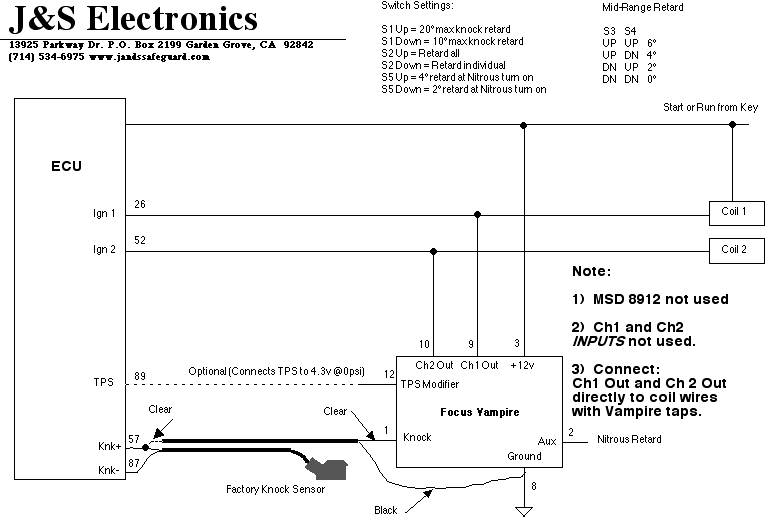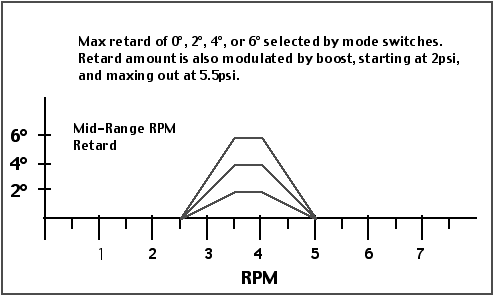
Instructions for the Focus Vampire unit, produced after 12/1/04:

1) The unit controls timing by changing the dwell on the coil drive signals.
2) Locate the two coil drive signals at pin 26 and 52 on the EECV computer. Using Vampire taps provided in the kit, splice the J&S Out1 wire to the wire in terminal 26, and splice J&S Out 2 into the wire in terminal 52.
3) Connect the Red wire to switched 12 volts. Coil positive is ideal, since 12v is present during Cranking as well as Run.
4) Connect the Black wire to chassis ground.
5) Locate the factory knock sensor wire in pin 57 of the EECV connector. Connect the “clear” wire in the J&S gray knock sensor cable (pin 1 of the J&S harness) to the factory knock sensor wire, using the wire splice provided.
6) (Optional) Using a wire splice, connect the Orange wire to the TPS signal wire at pin 89 of the ECU. This will pull the TPS signal to 4.5v at 2 psi, which should force the ECU into open loop.
7) If you are using nitrous oxide, connect the J&S Yellow wire to the nitrous switch. When you hit the nitrous switch, the unit will retard either 2° (S5 down) or 4° (S5 up). You could also wire pin 2 to a toggle switch, and use it to retard 2° or 4° when you fill up with low octane fuel.
8) At power-up, the unit performs a self check. The monitor LED will flash ten times over a two second period. At the same time, it will exercise an optional knock retard bargraph monitor if pluged into the monitor connector. The test will be aborted when the key is moved to the start position.
9) The LED above the monitor jack pulses during cranking and idle. Above 980 RPM, the function of the LED changes to show the amount of knock retard. With no knock retard, the LED will be off. When knock retard occurs, the LED brightness will increase in proportion to the amount of knock retard.
10) You are now ready to test the knock sensor. The unit will not detect knock unless the following conditions are met:
a) RPM must be above 1750 RPM
b) Vacuum drops below five inches.
11) Temporarily unplug and cap off the source of manifold vacuum. This forces the on board MAP sensor to 0 psi. Also, temporarily set mode switches 1 and 2 up, making it easier to tell if the unit is retarding.
12) Set the sensitivity control to mid-range, and hold the RPM to at least 2000. You should be able to hear the engine slow down as you tap rapidly on the knock sensor with a screwdriver. You can also see the timing retard with your timing light, and the Monitor LED on the front panel will glow dimly, increasing in brightness with increasing knock retard. If you have the J&S Knock/Retard Bargraph display, you can also see the amount of retard.
13) Once you have verified that the unit retards with knock, set mode select switches 1 and 2 down. This returns the unit to the individual cylinder retard mode, and 10° range. Reconnect the source of manifold pressure.
14) Sensitivity Adjust: Now you are ready for your test drive. A common mistake is to set the sensitivity control to maximum. This will usually cause the unit to over-retard due to engine noise. We recommend setting it to mid-range and getting the car up to highway cruising speed. To ensure that the unit is armed, find a slight hill, and run at 0 psi. This should be a low enough boost setting to avoid knock, but enough to arm the unit. Increase the sensitivity until the unit just starts to retard due to engine noise. This is easiest to do if you have purchased one of our knock retard monitors. If you don't have a monitor, the Monitor LED on the front panel will glow dimly, increasing in brightness with increasing knock retard. In any case, give the unit only as much sensitivity as it takes to make the ping go away.
15) Observe the monitor LED when setting the boost retard. Adjust the boost retard so that knock retard is kept at a minimum.
16) Boost Retard Start: The Start knob sets at what boost pressure the boost retard begins. Fully CCW, the boost retard starts at zero psi. Fully CW, and boost retard starts at 10 psi.
17) Boost Retard Rate: The boost retard rate is adjustable, from zero (fully CCW), to two degrees per psi (fully CW).
18) Mid-Range RPM Retard: Switches 3 and 4 allow you to select zero, two, four, or six degrees of midrange retard. The retard curve looks like a trapezoid. The height is selected by the switches and modulated by manifold pressure.
Operation is as follows:
Providing there is sufficient load, the unit will start retarding at 2500 RPM, and maxes out at the selected amount by 3500 RPM. At 4000 RPM, the unit will start re-advancing, reaching the stock setting by 5000 RPM.
Retard amount is also modulated by boost, starting at 2psi, and maxing out at 5.5psi.
